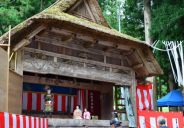|
|
|
|
|
|
| #07D201 |
|
|
|
|
|
| Rural KABUKI in OKU (inner part)-AIZU |
one of the traditional Japanese performing art |
 |

In the inner region of Aizu called Oku-Aizu, farmers have been performing kabuki since the Edo period. Kabuki at the Hinoemata village held around May and August or September is very famous.Kabuki has been designated an intangible cultural heritage by UNESCO. |
|

Minami Aizu county and Hinoemata village |
|
|
|
|
|
|
| #07D401 |
|
|
|
|
|
| AIZU JIDORI (local chicken) |
this has been handed down for over 500 years |
|
|
|

Aizu Jidori is raised for two to three times longer than broilers, in an
environment where they can move around freely (floor-raised), so the meat
is different from other chickens, has excellent richness and flavor.A rare
local chicken that has been handed down for over 500 years. |
|

Rural areas in Oku (inner part)-Aizu |
|
|
|
|
|
|
| #07D101 |
|
|
|
|
|
| JR TADAMI Line |
a spectacular view of a train running |
|
|
|

The most popular scenic spot is about a 10-minute walk up a mountain path from the nearest store. There are several other scenic spots nearby. |
 |

Mishima town |
|
|
|
|
|
|
| #07A301 |
|
|
|
|
|
| NIHON MITSUBACHI (Japanese honeybee) |
traditional Japanese beekeeping using hives |
|
|

The nectar of the Japanese honeybee, a species native to Japan, is a multi-flower
nectar blended with nectar from various flowers, and is said to have a
richer flavor than the nectar of Western honeybees. |
|

Mountain area in Oku-Aizu |
|
|
|
|
|
|
| #07D301 |
|
|
|
|
|
| HIGAERI Onsen (day trip Hot Spring) |
also can enjoy the open-air bath |
|
|

A lot of hot springs in this region have a history of over 1,000 years
and there are many natural medicinal with 100 percent natural spring water.
The baths are separated into men's and women's areas, and bathing clothes
such as swimsuits are not permitted. Also, due to ancient customs, people
with tattoos may be refused entry to the baths, so it is necessary to check
beforehand in that case. |
|

all over of Minami Aizu area |
|
|
|
|
|
|
| #07D202 |
|
|
|
|
|
| MAEZAWA Village |
L-Shaped Farmhouses |
|

|

Maezawa Village was designated as an Important Preservation District for Groups of Traditional Buildings by the national government in 2011.
The distinctive features of the buildings are the L-shaped curved houses with thatched roofs. As the village is an area with heavy snowfall, the Magariya houses (L-shaped curved houses) are designed so that people can live together with their precious cows and horses, who are indispensable to their lives. The protruding part in the front is for the cows and horses, while the building in the back is the living space for the people. The gables are highly designed, with skylights, wooden beams and crossbeams, carvings on the front lining, and fox lattice.
The distinctive feature of the houses is that people still live in them
today, retaining the appearance of the time. BTW, don't forget that here
is a bear habitat! |
 |

Maezawa, Minami Aizu town |
|
|
|
|
|
|
|
|
|
|
|
|
|
|
|
|
|
|
|
|
|
|
|
|
|
|
|
|
|
|